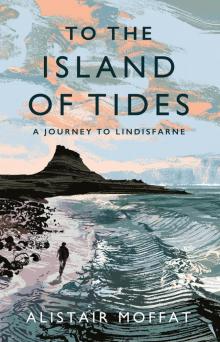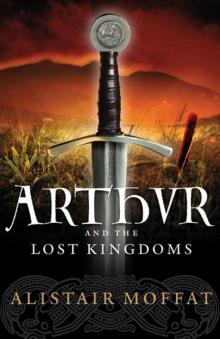- Home
- Alistair Moffat
The Wall Page 16
The Wall Read online
Page 16
At Vindolanda another tombstone commemorated Titus Annius, a centurion of the I Tungrian Cohort, possibly their acting commander, who was killed in the war, fought in 117 in Britain. All around the Empire native peoples were well aware of the shifts of imperial politics and knew that the death of an emperor and the shaky accession of another could herald a period of instability – and opportunity. In a list of the problems facing Hadrian in 117, a third-century historian noted that the Britons could not be kept under control. The kings in the north appear to have made a sustained attempt to take advantage of a moment of Roman weakness.
Annius’ death suggests that there might have been conflict on the Stanegate. If the Roman army had indeed been attempting to conscript young native men, resentment may have flared into open revolt. When the attacks came, they seem to have been savage – and effective. Both the II Augusta and the XX Valeria Victrix took heavy casualties and, in the initial period of his reign, Hadrian was forced to send 3,000 reinforcements to Britain. The historian Cornelius Fronto, writing not long afterwards, in 157, lamented the killing of many soldiers at the hands of the Britons. Even after thirty years of occupation, the hill peoples of the north still hated the Roman conquest and pitched themselves against a mighty empire to be rid of it.
By 119 it was reported that the barbarians had been scattered and the province of Britannia recovered, and coins were issued which showed the figure of Britannia (looking not unlike those which used to appear on old pennies) on the obverse in a submissive pose. The war, it seems, had been won – for the moment.
Hadrian knew that Britannia required sustained attention and he determined to give it personally. When news of his impending arrival spread in 122, the commander at Vindolanda put his soldiers to work. The fort would be an excellent base for any survey of the frontier and it is likely that the imperial household had sent word ahead. Well-appointed quarters were quickly built. Spacious, with plastered and painted walls, the house appears to have been a large courtyard building. The Emperor’s interest in architecture was well known and the work done will have been finished with great attention to detail.
Once the imperial visit was confirmed, another man went to work. It was well known that Hadrian liked to make himself accessible and was happy to receive petitions from his subjects in person. At Vindolanda the writer of the following probably believed that he had a good chance of getting his complaint into the Emperor’s hands. Over twenty centuries the anger is still palpable:
. . . he beat [?] me all the more . . . goods . . . or pour them down the drain[?] . . . As befits an honest man [?] I implore your majesty not to allow me, an innocent man, to have been beaten with rods and, my lord, inasmuch as [?] I was unable to complain to the prefect because he was detained by ill-health I have complained in vain [?] to the beneficiarius and the rest [?] of the centurions of [?] his unit. I accordingly implore your mercifulness not to allow me, a man from overseas and an innocent one, about whose good faith you may enquire, to have been bloodied by rods as if I had committed some crime.
The complainant appears to have been a civilian merchant from overseas. Whatever he had supplied had been thrown away, presumably because it had spoiled or been of poor quality. But the merchant insists that, whatever the merits of the dispute, he should not have been beaten – because he was from overseas. The clear corollary is that it was appropriate to beat Britons.
It is highly unlikely that the petition was ever put into the hands of His Majesty. The scribe asked by the merchant to write out a fair copy had probably gone to see the centurions. They then sought out the poor man, took the draft from him (it was found in the centurions’ quarters) and probably gave him another thrashing for his impudence.
The petition and the incidents around it are a fascinating, very human perspective on an event of immense significance. Hadrian had arrived on the northern frontier and, as he rode through the gates of Vindolanda, history was rumbling into place. Within ten years his plans and wishes would transform the north forever, and the greatest monument to Roman power would ribbon through the Northumbrian and Cumbrian countryside.
5
The Day the Empire Came
Carefully coasting up past Flamborough Head, on beyond the reed marshes at the mouth of the River Tees and other familiar sea-marks, the Classis Britannica, the British fleet, brought the Empire north. Based at Boulogne, and with depots at Dover, Chester and other ports, the British fleet was impressive. About 7,000 men were under the command of its trierarchs, the sea-captains, and by the AD 120s more than fifty ships were in active service. Most of these were biremes, what the Romans knew as liburnae after the Adriatic pirates who first built and developed them. Fast, sleek and manoeuvrable, these ships sliced through the water and, when the wind billowed their single square sail and their banks of oarsmen bent their backs, they could make good headway. Each beak had a large and menacing eye painted on either side; the effect was shark-like.
When watchers on the headland at Tynemouth looked south and scanned the horizon some time in the summer of 122, they will have made out many coloured sails and brightly painted hulls glinting in the sunshine. But one ship dwarfed all the others. Pushed forward by a purple sail with the imperial inscription picked out in gold lettering at its top, a trireme surged through the waves. Evidence for the existence of only one trireme in the British fleet has come to light. On a relief discovered at Boulogne, the Radians is recorded. Perhaps it was this ship, The Gleamer, which made its stately way up the North Sea coast.
In its belly three banks of oarsmen on each side pulled hard to the commands of the Pausarius, the cox who called all the different speeds. To keep all in time, the Pitulus pounded a wooden block with a mallet, and his stroke-oarsmen on the benches beside him set the rhythm. On deck the Trierarch looked anxiously at the approaching river-mouth. Like most estuaries, the Tyne’s could be treacherous, sandbars shifting with the tides, silt washed down with seasonal spates. As the great trireme glided nearer, the Proreta made his way forward to a station in the prow. Leaning over and searching the surface of the water for telltale ripples and eddies around hidden obstructions or shallows, he called instructions back to the Gubernator and his men on the steering oar.
Immense care was taken, no pains spared to make the entrance into the Tyne uneventful, comfortable and impressive. The Gleamer carried the world’s most precious cargo – the world’s most important man. Publius Aelius Hadrianus had become Emperor of Rome in AD 117, the adopted successor of Trajan. He inherited a vast domain stretching from the Tigris to the Tyne. His professional standing army numbered thirty legions, almost 200,000 highly trained men in a state of constant readiness. The Roman Empire seemed to contemporaries invincible – even eternal. In fact it lasted from 753 BC when Rome was founded to 1453 when New Rome, or Constantinople, fell to the Turks and the last Emperor was killed as he plunged into the street-fighting. Unparalleled in history, the mighty Empire endured for 2,206 years. And Hadrian was one of its most powerful emperors, his reign falling in the middle of what historians have labelled Rome’s Golden Age, the period between AD 96 and the death of Marcus Aurelius in 180. The Proreta craning his neck over the prow of The Gleamer will never have dared take his eyes off the water.
Although its remains have disappeared under the modern town, it is likely that there was a depot of the Classis Britannica at South Shields. So, when the imperial trireme trimmed its purple sail and the Pausarius called for his oarsmen to hold steady, it may be that a local pilot sailed out to advise the Trierarch on the state of the tides. Passage upriver would be much easier and much faster with an indrawn tide running against the current.
The Tyne looked different 2,000 years ago. The banks of the river were not built up and lined with wharves and walls as they are now, and the flow was not canalised except at Gateshead where the gorge forced it into a natural channel. Reedbeds, mudflats such as Jarrow Slake, oxbows and river-islands made navigation more difficult, and the last thing the fleet co
mmanders wanted was the inconvenience and humiliation of running aground as the Emperor looked on.
DYNASTY
Julius Caesar’s pivotal role in establishing the Empire and its emperors has been remembered by imitation. The imperial titles of Kaiser and Tsar are corruptions of his name. Irony was at work. In Latin ‘Caesar’ means ‘hairy’, but Julius was famously bald. His name was also attached to the first of many imperial dynasties.
The Julio-Claudians were:
Augustus 31 BC–AD 14
Tiberius AD 14–37
Caligula 37–41
Claudius 41–54
Nero 54–68
In the chaos after Nero’s suicide came the Year of the Four Emperors:
Galba 68–69
Otho 69
Vitellius 69
And then the brief interlude of the Flavians:
Vespasian 69–79
Titus 79–81
Domitian 81–96
After Domitian’s assassination there followed a continuous succession of successful emperors. It must be highly significant that this was not a dynasty of sons following fathers but a series of adoptions of competent soldiers and senators with proven abilities. And Nerva was also the last Italian emperor in this sequence:
Nerva 96–98
Trajan 98–117
Hadrian 117–138
Antoninus Pius 138–161
Marcus Aurelius 161–180
And then the sequence was broken when Commodus, 180–192, inherited the throne from his father and was ultimately removed.
Others were watching too. From the fort at Newcastle a screen of cavalry units will have patrolled both banks of the river. Although the Romans had been on the Tyne for more than forty years, no chances would have been taken. And since prestige and the power of show always played a central part in Roman politics, native princes may have been encouraged to watch as the Classis Britannica brought Publius Aelius Hadrianus, the greatest prince of all, to his most northerly frontier.
PROPINQUITY
Publius Aelius Hadrianus’ family came from southern Spain and they were amongst the earliest provincials to be admitted to the Senate. Fascinated by Greek culture from boyhood, Hadrian was known as ‘Graeculus’ and he also became a passionate huntsman. On the death of his father, the boy became the ward of a family cousin, Trajan (also from southern Spain), and in 97 Hadrian was sent directly into the centre of power when he was despatched to congratulate his patron on being adopted as the successor of the Emperor Nerva. As with modern politics, nothing propinks like propinquity. In Dacia, now Romania, he fought a famous campaign with Trajan. When the Emperor led the legions east to confront the Persians, Hadrian was by his side once more. Timely positioning was everything and, as Governor of Syria at the time Trajan died in the neighbouring province of Cilicia, Hadrian was on hand in 117 when his chance finally came.
The quays at Newcastle were almost certainly his destination. Two years before, 3,000 men disembarked there from transports which had brought them from the legions stationed on the Lower Rhine. They arrived as reinforcements for a campaign against the northern British kings and their warbands. During the journey up the Tyne, one legionary, the unfortunate Junius Dubitatus, dropped his shield into the river. His centurion will certainly have beaten him for such carelessness and probably docked his pay for the cost of a replacement. Buried deep in the murky silt of the Tyne, the wooden shield rotted but its metal boss, the umbo, survived and was dredged up 2,000 years after Junius lost it. Nearby, another, much smaller, circular piece of metal was pulled out of the river. A Roman coin, a sestertius, shows a trireme with the Emperor Hadrian enthroned under a canopy in the stern. He is flanked by two standards, what seem to be an imperial eagle and a legionary standard. Mounted in the prow is a wind-god, an addition which strongly suggests the erection of a symbol of thanks for the successful completion of a sea voyage. This interpretation is supported by the inscription on the sestertius. It reads: For the good fortune of the Emperor, three times Consul, Father of his Country. Much more comfortable travelling overland, Romans were very superstitious sailors, especially outside the placid Mediterranean, and the good fortune may represent more thanks for a safe deliverance. The coin was almost certainly struck as a commemorative issue.
Hadrian arrived at the Newcastle quays some time before 17 July 122. By that date Platorius Nepos is recorded as the new provincial Governor of Britannia. His immediate previous posting had been to Germania Inferior, the Lower Rhine, and the outpost of the Empire visited by Hadrian before his journey to Britain. As The Gleamer hove to in the Gateshead Gorge, it is very likely that Nepos and Hadrian both stood on its deck.
ACROSS THE OCEAN
Without the inflow of cold water through the Strait of Gibraltar, the Mediterranean would evaporate. Its feeder-rivers and water from the Black Sea are insufficient to maintain its levels. The strong current through the Strait created an anti-clockwise series of ancient trade-routes. Carried on the Atlantic inflow, ships were driven along the North African coast, up to the Syrian shores and Cyprus and on into the Aegean. Mediterranean winds were seasonal and generally predictable. But the Bora, the Scirocco and especially the Mistral could be stormy; the Gulf of Lion is so named because the Mistral could roar like a lion. So it was not bad weather which made the Romans anxious about crossing the English Channel or the North Sea, what they called ‘the Ocean’. Unfamiliarity, a fear of currents which might drag them, literally, into the middle of nowhere (the open sea – very different from the comforting enclosure of the Mediterranean) and the much more extreme rise and fall of tides – these conditions were what worried the trierarchs. The Classis Britannica almost certainly depended from the outset on local pilots and local knowledge.
Many others accompanied the Emperor to the Tyne. Wherever Hadrian went – and he travelled the length and breadth of the Roman world – the apparatus of state followed. To all practical intents the place that became Newcastle, and not Rome, was the imperial capital in the summer of 122. Detachments of the VI Legion, the Victrix, sailed up the river but they were not the only soldiers in Hadrian’s retinue, nor the most important. First formally recruited by the Emperor Augustus, the Praetorians were the personal imperial bodyguards, an elite drawn from all of the regular army’s legions. Politically very powerful, they had dragged the cowering Claudius from behind a curtain after Caligula’s assassination and made him emperor, much against his will. And in 193 their commanders auctioned the throne to Didius Julianus for a vast sum.
To protect Hadrian and the imperial court, the Prefect of the Praetorian Guard, Septicius Clarus, brought a substantial force, and he himself would have been a weighty figure, widely feared – not least by the Emperor, as matters turned out. A great historian also sailed up the Tyne, although sadly he did not record the journey. Suetonius Tranquillus was Hadrian’s chief civil servant, variously described as Secretary or Director of Chancery. All of the important administrative machinery of running a vast empire of thirty-six provinces implies a great government department packed into the liburnae following the imperial trireme: clerks, accountants, messengers and more clerks.
Much of the flummery and panoply of the imperial court had to be left behind in Rome’s palaces and forums. The northern frontier was no setting for elaborate ceremony or set-piece ritual. But the courtiers came. If he had any sense, each emperor brought influential senators with him on his travels. Not only did he need witnesses to attest to his prowess in leading the army and dealing with barbarians, he also wanted to neutralise intrigue and opposition back in Rome. Near-contemporary records of arrangements made for their provisioning and accommodation show hundreds, perhaps more than a thousand people, in the imperial entourage. When Claudius had sailed to Britannia to join the invading army in AD 43, he had had a large contingent of important senators in his retinue and, although they are not named, influential aristocrats would certainly have travelled with Hadrian in 122.
Ever watchful, the Emper
or realised that intelligence-gathering was a key to survival and success. In the past the Praetorian Guard had acted as spies and enforcers when the court was in Rome, but Hadrian needed something more reliable and with an Empire-wide reach. The frumentarii were tax collectors in the provinces, taking much of their revenue in corn, frumentum in Latin. As travelling officials they were well placed to compile information and make regular reports. Letters carried by the imperial postal service were often intercepted, and one in which the wife of a provincial official wrote to her husband chiding him for idleness became famous. When the official appeared before the Emperor requesting leave, Hadrian refused, saying that the man was too lazy to deserve it. What!? he is said to have blurted out, Has my wife been complaining to you too?
The sinister hand of the frumentarii almost certainly caused an eruption in the imperial court in 122, probably in Britain. Hadrian:
replaced Septicius Clarus, Prefect of the Guard, and Suetonius Tranquillus, Director of the Chancery, and many others, because they had at that time, in their relations with his wife, Sabina, behaved with greater familiarity than the etiquette of the court required.

 The Secret History of Here
The Secret History of Here The Night Before Morning
The Night Before Morning To the Island of Tides
To the Island of Tides Arthur and the Lost Kingdoms
Arthur and the Lost Kingdoms Britain’s Last Frontier
Britain’s Last Frontier The Faded Map: The Lost Kingdoms of Scotland
The Faded Map: The Lost Kingdoms of Scotland The Wall
The Wall